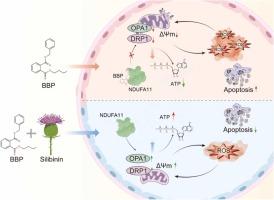多组学分析揭示水飞蓟宾挽救邻苯二甲酸丁苄酯对猪着床前胚胎毒性作用的分子机制
IF 11.3
1区 环境科学与生态学
Q1 ENGINEERING, ENVIRONMENTAL
引用次数: 0
摘要
邻苯二甲酸丁苯酯(BBP)是一种广泛使用的增塑剂和溶剂,由于其在环境和人体中的普遍存在,引发了人们对其潜在健康风险的担忧。本研究旨在揭示BBP对着床前胚胎发育的影响及其潜在机制。实验结果表明,BBP暴露显著抑制了早期胚胎的发育过程,降低了胚胎到达关键形成阶段的比例。通过转录组学和代谢组学分析,我们发现BBP暴露导致与线粒体功能和蛋白质翻译相关的基因表达和代谢物水平发生显著变化,并伴有内质网和高尔基体的结构损伤。研究还发现,BBP可能通过与线粒体膜蛋白NDUFA11相互作用,破坏线粒体功能,从而诱导氧化应激和细胞凋亡。本研究的创新之处在于提出天然抗氧化剂水飞蓟宾可有效缓解bbp诱导的胚胎发育障碍,为保护孕产妇生殖健康提供新的策略。这项工作不仅为了解BBP的胚胎毒性提供了科学依据,而且为环境内分泌干扰物的健康风险评估和预防提供了重要的见解。本文章由计算机程序翻译,如有差异,请以英文原文为准。

Multi-omics analysis reveals the molecular mechanism of silibinin rescue the toxic effects of butyl benzyl phthalate on porcine preimplantation embryos
Butyl benzyl phthalate (BBP), a widely used plasticizer and solvent, has raised concerns due to its pervasive presence in the environment and human bodies, prompting worries about its potential health risks. This study aims to uncover the impact of BBP on pre-implantation embryo development and its underlying mechanisms. The experimental results indicate that BBP exposure significantly inhibits the development process of early embryos, reducing the proportion of embryos reaching key formation stages. Through transcriptomic and metabolomic analyses, we found that BBP exposure leads to marked changes in gene expression and metabolite levels associated with mitochondrial function and protein translation, accompanied by structural damage to the endoplasmic reticulum and Golgi apparatus. The study also reveals that BBP may disrupt mitochondrial function through interaction with the mitochondrial membrane protein NDUFA11, thereby inducing oxidative stress and apoptosis. The innovation of this research lies in proposing that silibinin, a natural antioxidant, can effectively alleviate BBP-induced developmental disorders in embryos, offering a new strategy for protecting maternal reproductive health. This work not only provides a scientific basis for understanding the embryotoxicity of BBP but also offers important insights for the health risk assessment and prevention of environmental endocrine disruptors.
求助全文
通过发布文献求助,成功后即可免费获取论文全文。
去求助
来源期刊

Journal of Hazardous Materials
工程技术-工程:环境
CiteScore
25.40
自引率
5.90%
发文量
3059
审稿时长
58 days
期刊介绍:
The Journal of Hazardous Materials serves as a global platform for promoting cutting-edge research in the field of Environmental Science and Engineering. Our publication features a wide range of articles, including full-length research papers, review articles, and perspectives, with the aim of enhancing our understanding of the dangers and risks associated with various materials concerning public health and the environment. It is important to note that the term "environmental contaminants" refers specifically to substances that pose hazardous effects through contamination, while excluding those that do not have such impacts on the environment or human health. Moreover, we emphasize the distinction between wastes and hazardous materials in order to provide further clarity on the scope of the journal. We have a keen interest in exploring specific compounds and microbial agents that have adverse effects on the environment.
 求助内容:
求助内容: 应助结果提醒方式:
应助结果提醒方式:


